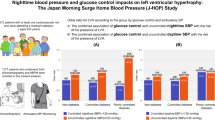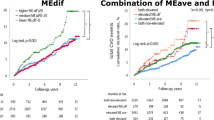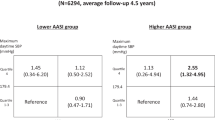Abstract
We tested our hypothesis that the association between N-terminal pro-brain natriuretic peptide (NT-proBNP) and cardiovascular disease (CVD) events is mediated in part by a pathway of increased nighttime blood pressure (BP) that involves volume overload. We used the data from the Japan Morning Surge-Home Blood Pressure (J-HOP) Nocturnal BP Study, which targeted 2476 Japanese participants who had a history of or risk for CVD (mean age 63.8 ± 10.2 years), along with their measured nighttime BP values assessed by a home BP device (measured at 2:00, 3:00 and 4:00 a.m.) and NT-proBNP levels. At baseline, elevated daytime (average of morning and evening) and nighttime home systolic BP (SBP) were independently associated with log-transformed NT-proBNP levels after adjustment for cardiovascular risk factors. During a median follow-up of 7.2 years, 150 participants experienced a CVD event (62 stroke events and 88 coronary artery disease events). After adjustment for cardiovascular risk factors and nighttime SBP, increased log-transformed NT-proBNP levels were independently associated with CVD events (hazard ratio [HR] per 1 unit, 1.67; 95% confidence interval [CI]: 1.16–2.40). Elevated nighttime home SBP was also independently associated with CVD events after adjustment for cardiovascular risk and log-transformed NT-proBNP (HR per standard deviation, 1.22; 95% CI: 1.001–1.50). The percentage of the association between NT-proBNP and CVD events mediated by nighttime home SBP was 15%. Our findings indicate a physiological pathway in which increased nighttime SBP contributes to the impact of elevated NT-proBNP levels on the incidence of CVD.
This is a preview of subscription content, access via your institution
Access options
Subscribe to this journal
Receive 12 print issues and online access
$259.00 per year
only $21.58 per issue
Buy this article
- Purchase on Springer Link
- Instant access to full article PDF
Prices may be subject to local taxes which are calculated during checkout

Similar content being viewed by others
References
Whelton PK, Carey RM, Aronow WS, Casey DE Jr., Collins KJ, Dennison Himmelfarb C, et al. 2017 ACC/AHA/AAPA/ABC/ACPM/AGS/APHA/ASH/ASPC/NMA/PCNA guideline for the prevention, detection, evaluation, and management of high blood pressure in adults: Executive summary: a report of the American College of Cardiology/American Heart Association task force on clinical practice guidelines. Hypertension. 2018;71:1269–324.
Williams B, Mancia G, Spiering W, Agabiti Rosei E, Azizi M, Burnier M, et al. 2018 ESC/ESH guidelines for the management of arterial hypertension: The task force for the management of arterial hypertension of the European Society of Cardiology and the European society of hypertension. J Hypertens. 2018;36:1953–2041.
Umemura S, Arima H, Arima S, Asayama K, Dohi Y, Hirooka Y, et al. The Japanese Society of Hypertension guidelines for the management of hypertension (JSH 2019). Hypertens Res. 2019;42:1235–481.
Boggia J, Li Y, Thijs L, Hansen TW, Kikuya M, Björklund-Bodegård K, et al. Prognostic accuracy of day versus night ambulatory blood pressure: a cohort study. Lancet. 2007;370:1219–29.
Kario K, Kanegae H, Tomitani N, Okawara Y, Fujiwara T, Yano Y, et al. Nighttime blood pressure measured by home blood pressure monitoring as an independent predictor of cardiovascular events in general practice. Hypertension. 2019;73:1240–8.
Mokwatsi GG, Hoshide S, Kanegae H, Fujiwara T, Negishi K, Schutte AE, et al. Direct comparison of home versus ambulatory defined nocturnal hypertension for predicting cardiovascular events: the Japan Morning Surge-Home Blood Pressure (J-HOP) study. Hypertension. 2020;76:554–61.
Kario K. Nocturnal hypertension: new technology and evidence. Hypertension. 2018;71:997–1009.
Kimura G. Kidney and circadian blood pressure rhythm. Hypertension. 2008;51:827–8.
Uzu T, Ishikawa K, Fujii T, Nakamura S, Inenaga T, Kimura G. Sodium restriction shifts circadian rhythm of blood pressure from nondipper to dipper in essential hypertension. Circulation. 1997;96:1859–62.
Uzu T, Kimura G. Diuretics shift circadian rhythm of blood pressure from nondipper to dipper in essential hypertension. Circulation. 1999;100:1635–8.
Mukoyama M, Nakao K, Saito Y, Ogawa Y, Hosoda K, Suga S, et al. Human brain natriuretic peptide, a novel cardiac hormone. Lancet. 1990;335:801–2.
Kario K, Hoshide S, Haimoto H, Yamagiwa K, Uchiba K, Nagasaka S, et al. Sleep blood pressure self-measured at home as a novel determinant of organ damage: Japan morning surge home blood pressure (J-HOP) study. J Cin Hypertens. 2015;17:340–8.
Tabara Y, Igase M, Miki T, Ohyagi Y, Matsuda F, Kohara K. B-type natriuretic peptide is a determinant of the nocturnal increase in blood pressure independently of arterial hypertrophy and hypoxia. J Hypertens. 2016;34:2393–401.
Yano Y, Hoshide S, Shimizu M, Eguchi K, Ishikawa J, Ishikawa S, et al. Association of home and ambulatory blood pressure changes with changes in cardiovascular biomarkers during antihypertensive treatment. Am J Hypertens. 2012;25:306–12.
Ponikowski P, Voors AA, Anker SD, Bueno H, Cleland JG, Coats AJ, et al. 2016 ESC guidelines for the diagnosis and treatment of acute and chronic heart failure: the task force for the diagnosis and treatment of acute and chronic heart failure of the European Society of Cardiology (ESC). Developed with the special contribution of the heart failure association (HFA) of the ESC. Eur J Heart Fail. 2016;18:891–975.
Yancy CW, Jessup M, Bozkurt B, Butler J, Casey DE Jr., Colvin MM, et al. 2017 ACC/AHA/HFSA focused update of the 2013 ACCF/AHA guideline for the management of heart failure: a report of the american college of cardiology/american heart association task force on clinical practice guidelines and the heart failure society of america. Circulation. 2017;136:e137–e161.
Neeland IJ, Drazner MH, Berry JD, Ayers CR, deFilippi C, Seliger SL, et al. Biomarkers of chronic cardiac injury and hemodynamic stress identify a malignant phenotype of left ventricular hypertrophy in the general population. J Am Coll Cardiol. 2013;61:187–95.
Paget V, Legedz L, Gaudebout N, Girerd N, Bricca G, Milon H, et al. N-terminal pro-brain natriuretic peptide: a powerful predictor of mortality in hypertension. Hypertension. 2011;57:702–9.
Wang TJ, Larson MG, Levy D, Benjamin EJ, Leip EP, Omland T, et al. Plasma natriuretic peptide levels and the risk of cardiovascular events and death. N Engl J Med. 2004;350:655–63.
McKie PM, Rodeheffer RJ, Cataliotti A, Martin FL, Urban LH, Mahoney DW, et al. Amino-terminal pro-b-type natriuretic peptide and b-type natriuretic peptide: Biomarkers for mortality in a large community-based cohort free of heart failure. Hypertension. 2006;47:874–80.
Natriuretic Peptides Studies C, Willeit P, Kaptoge S, Welsh P, Butterworth AS, Chowdhury R, et al. Natriuretic peptides and integrated risk assessment for cardiovascular disease: an individual-participant-data meta-analysis. Lancet Diabetes Endocrinol. 2016;4:840–9.
Hoshide S, Yano Y, Haimoto H, Yamagiwa K, Uchiba K, Nagasaka S, et al. Morning and evening home blood pressure and risks of incident stroke and coronary artery disease in the japanese general practice population: the Japan Morning Surge-Home Blood Pressure study. Hypertension. 2016;68:54–61.
Hoshide S, Yano Y, Mizuno H, Kanegae H, Kario K. Day-by-day variability of home blood pressure and incident cardiovascular disease in clinical practice: The J-HOP study (Japan Morning Surge-Home Blood Pressure). Hypertension. 2018;71:177–84.
Pickering TG, Hall JE, Appel LJ, Falkner BE, Graves J, Hill MN, et al. Recommendations for blood pressure measurement in humans and experimental animals: Part 1: Blood pressure measurement in humans: a statement for professionals from the subcommittee of professional and public education of the american heart association council on high blood pressure research. Hypertension. 2005;45:142–61.
Parati G, Stergiou GS, Asmar R, Bilo G, de Leeuw P, Imai Y, et al. European Society of Hypertension practice guidelines for home blood pressure monitoring. J Hum Hypertens. 2010;24:779–85.
Imai Y, Kario K, Shimada K, Kawano Y, Hasebe N, Matsuura H. et al.The Japanese Society of Hypertension guidelines for self-monitoring of blood pressure at home (second edition). Hypertens Res.2012;35:777–95.
Valeri L, Vanderweele TJ. Mediation analysis allowing for exposure-mediator interactions and causal interpretation: Theoretical assumptions and implementation with SAS and SPSS macros. Psychol Methods. 2013;18:137–50.
Valeri L, VanderWeele TJ. Sas macro for causal mediation analysis with survival data. Epidemiology. 2015;26:e23–24.
Maeder MT, Mariani JA, Kaye DM. Hemodynamic determinants of myocardial b-type natriuretic peptide release: relative contributions of systolic and diastolic wall stress. Hypertension. 2010;56:682–9.
Sarzani R, Spannella F, Giulietti F, Balietti P, Cocci G, Bordicchia M. Cardiac natriuretic peptides, hypertension and cardiovascular risk. High Blood Press Cardiovasc Prev. 2017;24:115–26.
Franklin SS, Larson MG, Khan SA, Wong ND, Leip EP, Kannel WB, et al. Does the relation of blood pressure to coronary heart disease risk change with aging? The framingham heart study. Circulation. 2001;103:1245–9.
Li Y, Wei FF, Thijs L, Boggia J, Asayama K, Hansen TW, et al. Ambulatory hypertension subtypes and 24-hour systolic and diastolic blood pressure as distinct outcome predictors in 8341 untreated people recruited from 12 populations. Circulation. 2014;130:466–74.
Ishikawa J, Hoshide S, Eguchi K, Ishikawa S, Shimada K, Kario K. Nighttime home blood pressure and the risk of hypertensive target organ damage. Hypertension. 2012;60:921–8.
Ragot S, Genès N, Vaur L, Herpin D. Comparison of three blood pressure measurement methods for the evaluation of two antihypertensive drugs: Feasibility, agreement, and reproducibility of blood pressure response. Am J Hypertens. 2000;13:632–9.
Fujiwara T, Nishizawa M, Hoshide S, Kanegae H, Kario K. Comparison of different schedules of nocturnal home blood pressure measurement using an information/communication technology-based device in hypertensive patients. J Clinl Hypertens. 2019;21:1594–5.
Narita K, Hoshide S, Kanegae H, Kario K. Seasonal variation in masked nocturnal hypertension: the J-HOP nocturnal blood pressure study. Am J Hypertens. 2020:hpaa193: https://doi.org/10.1093/ajh/hpaa193.
Tabara Y, Matsumoto T, Murase K, Nagashima S, Hirai T, Kosugi S, et al. Seasonal variation in nocturnal home blood pressure fall: The Nagahama study. Hypertens Res. 2018;41:198–208.
Cuspidi C, Gherbesi E, Tadic M. Is obstructive sleep apnoea the most important determinant of reverse dipping? Hypothesis and evidence. J Clin Hypertens. 2019;21:1594–5.
Kario K, Chia YC, Sukonthasarn A, Turana Y, Shin J, Chen CH, et al. Diversity of and initiatives for hypertension management in Asia-why we need the HOPE Asia network. J Clin Hypertens. 2020;22:331–43.
Kawauchi D, Hoshide S, Kario K. Morning home blood pressure and cardiovascular events in a japanese general practice population over 80 years old: the J-HOP study. Am J Hypertens. 2018;31:1190–6.
Acknowledgements
We thank all of the participants and investigators involved in the J-HOP study.
Funding
This study was financially supported in part by a grant from the 21st Century Center of Excellence Project run by Japan’s Ministry of Education, Culture, Sports, Science, and Technology (to KK); a grant from the Foundation for Development of the Community (Tochigi, Japan); and a grant from Omron Healthcare, Co., Ltd.; a Grant-in-Aid for Scientific Research (B) (21390247) from the Ministry of Education, Culture, Sports, Science and Technology (MEXT) of Japan, 2009–2013; and funds from the MEXT-Supported Program for the Strategic Research Foundation at Private Universities, 2011–2015 Cooperative Basic and Clinical Research on Circadian Medicine (S1101022).
Author information
Authors and Affiliations
Corresponding author
Ethics declarations
Conflict of interest
KK has received research grants from Omron Healthcare and A&D Co. The other authors have no competing interests to declare.
Additional information
Publisher’s note Springer Nature remains neutral with regard to jurisdictional claims in published maps and institutional affiliations.
Supplementary information
Rights and permissions
About this article
Cite this article
Hoshide, S., Kanegae, H. & Kario, K. Nighttime home blood pressure as a mediator of N-terminal pro-brain natriuretic peptide in cardiovascular events. Hypertens Res 44, 1138–1146 (2021). https://doi.org/10.1038/s41440-021-00667-5
Received:
Revised:
Accepted:
Published:
Issue Date:
DOI: https://doi.org/10.1038/s41440-021-00667-5
Keywords
This article is cited by
-
Development of beat-by-beat blood pressure monitoring device and nocturnal sec-surge detection algorithm
Hypertension Research (2024)
-
Impact of nocturnal blood pressure dipping on recurrence of atrial fibrillation after pulmonary vein isolation
Hypertension Research (2024)
-
Placental hypoxia, high nighttime blood pressure, and maternal health
Hypertension Research (2024)
-
Nighttime blood pressure and glucose control impacts on left ventricular hypertrophy: The Japan Morning Surge Home Blood Pressure (J-HOP) Study
Hypertension Research (2024)
-
Circadian rhythm in cardiovascular diseases: a bibliometric analysis of the past, present, and future
European Journal of Medical Research (2023)



